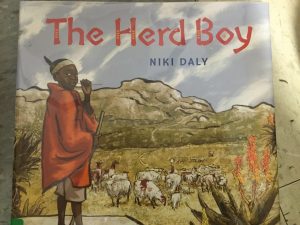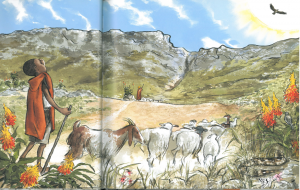
Author/ Illustrator: Niki Daly
Publishing Information: Frances Lincoln Limited, 2012
Number of Pages: 30
Genre: Non-fiction, Picture book

Analysis:
Malusi is a South African herd boy. The job is very hard but he does it very well. He and his friend both have their own dreams. While his friend Lungisa wants to be a soccer player, Malusi wants to be president when he grows up.
This book demonstrates multiculturalism through a typical day of a South African herb boy Malusi. The text functions as a window for children to notice and explore the differences in the world. On the other side of the earth, there are different types of food, different clothes, and people with different skin color speaking different language. The kids there do not live in fancy houses. They get up early to work instead of rushing to catch the school bus in order not to be late. They take care of animals not for fun but for a living. This book was published just a few years ago. However, I can hardly find any modern elements from both texts and illustrations. It shows children that people elsewhere are living a very different life. People can be different in various ways but dreams are universal.
I found one of the plots in this story problematic. Children might be confused when they saw Nelson Mandela in “a shiny new car” with a man in suit driving for him (p. 21). On one hand, the strong contrast between the car and “the dirt road” reveal the gap between different classes. On the other hand, it is a symbol for a hope of development country, both in wealth and in technology. I think a better way to express this plot is to talk more about how Nelson Mandela gets to his place and further specify the necessary characteristics of leadership.
Perceptually, the book uses narrative sentences to tell a relatively complete story. Almost all of the colors in the book are dark which reflects the relatively poor living condition. The pictures in the book are not framed but the text and images are completely separated which construct the feeling of looking into another world and another culture. The horizon exists all the time except for the last picture which depicted Malusi’s dream. Structurally, the text and images do not overlap. Ideologically, the story encourages children to be brave. When facing difficulties, keep calm and find the best solution. At the same time, it is okay to have dreams and fight for them — even if they seem to be unreachable right now.
